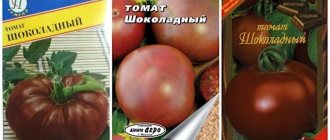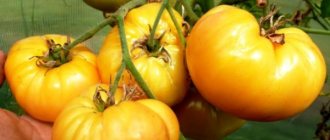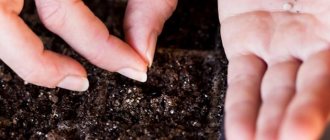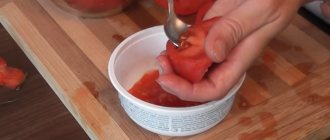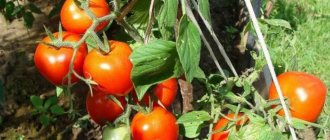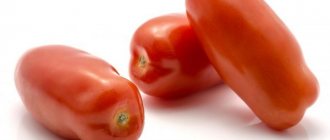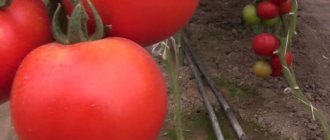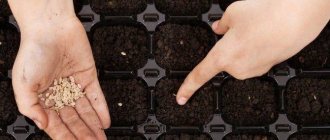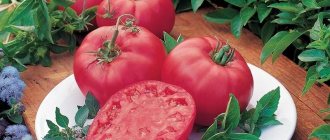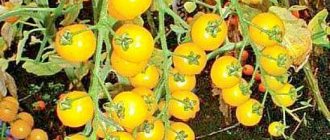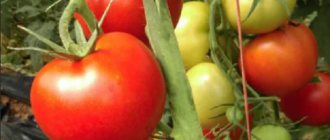The idea of regions with short summers and harsh winters as unpromising for growing vegetables is incorrect. Since Michurin’s times, Siberia has been able to grow many traditionally “southern” plants. Tomatoes work well in local conditions.
Gardeners know: you can get the desired harvest only by having a good understanding of the varieties suitable for the cultivation zone. How to “force” a tomato fruit to grow like a sprint, gain weight, and ripen is more the task of the breeder. You also need to be able to follow agricultural techniques and invest your own experience.
But no miracles of agricultural techniques will help if the wrong variety is chosen. Not zoned. The southern half-kilogram bogatyr at an unusual latitude and longitude can grow the size of a plum. Dozens of tomato varieties adapted to the Spartan conditions of Siberia have been created. All that remains is to familiarize yourself with their list, the characteristics of the culture, and decide which one to give preference to.
Let's consider what to consider and what parameters to focus on when choosing a variety.
Vegetable growing in any climate zone is divided into two types:
- Greenhouse cultivation;
- Open ground culture.
We grow it in a greenhouse and purchase a variety adapted to these conditions. We plan to get a harvest without shelter - we are looking for tomato seeds for open ground.
I want to catch two birds with one stone: no problem. Selection has provided for this too, creating varieties of a universal type: even if you plant it in a greenhouse, it works, even without shelter.
Disease-resistant tomatoes are good for greenhouses in Siberia. The humidity under the shelter is high, temperature fluctuations are large. These two factors exclude the cultivation of plants that are not resistant to late blight (the scourge of nightshade crops).
We choose diseases-resistant and early-ripening ones. Late or middle ones may not have time to form fruits.
Tall or compact, small in stature (indeterminate or scientifically determinant) - according to the taste and according to the possibilities. The height of the greenhouse allows, there is a desire to get plants as tall as you are, tie them up regularly: indeterminate ones are suitable. For busy gardeners or gardeners who prefer not to have much trouble, it is better to grow small plants with strong stems.
Experienced gardeners select a variety based on several parameters at once. So that he suits them with everything: hardiness (cold resistance, immunity to diseases), size of the bush and fruit, yield, taste, keeping quality (transportability if necessary). It’s a good idea to have one or two varieties, the fruits of which can ripen after being picked from the bush. Ripening, as the process is called, will extend the time of fresh tomatoes on the Siberian’s table.
Appointment is not the last item on the list. Salad may be enough, but more often plant growers will prefer universal use: salad, canning, for storage without processing.
The description on the seed packaging is always laudatory. Law of trade. Notice the details. If they write a “northern” variety, it is not a fact that it is suitable for Siberia. No matter how cold-resistant and early ripening it may be. The length of daylight hours in a region has an effect. Northern white nights are the same lengthened day. Siberia, with a similar short summer, is inferior to the North in terms of day length. Plants react to this: they can grow leaves and not set fruit. Or they will bloom in a hurry, without gaining the required growth and green mass.
It is best to purchase the best seeds of local, Siberian selection:
- Alsou,
- Heavyweight of Siberia,
- Dad,
- Siberian malachite,
- Scarlet candles,
- Conqueror of the North,
- Siberian early ripening,
- Siberian sweets,
- Siberian Troika, Altaechka,
- Nobleman,
- A great warrior,
- Sensei,
- Pink honey
- and many others.
Review of varieties for Siberia
Practice has shown that the following varieties can withstand the greenhouse conditions of Siberia:
Scarlet candles
It works only in shelters (greenhouses, film). Indeterminate (tall), tomatoes 120 g, pink, dense, oblong, with a spout. Interestingly, the color of the “scarlet” candles is pink. All flowers form ovaries - a rare quality. Universal in consumption: fresh, canned, can be preserved by pickling.
Abakan pink
Greenhouse-grown, grows and ripens quickly. Indeterminate, will have to be tied up. But it will not disappoint with its large fruit, a real giant of the best. Weight 500 g, or even 900. The color corresponds to the name, the shape is heart-shaped.
Bulat F1
Advantageously early ripening (ultra-early), it manages to ripen after germination in 80 - 90 days. The short growing season coincides with the period of sufficient summer illumination. The variety is suitable for both the North and Siberia. Cold-hardy, low (up to 70 cm), productive, not susceptible to disease. Lays easily and is transportable. Quite a size, up to 150 g. Cultivation: greenhouses, open ground.
Dad
It is characterized by similar qualities: three months before ripening, adapted to the Siberian climate, grows in greenhouses, can be planted without shelter in open ground. Differences: “Conqueror of the North F1” ripens together, the “Batyanya” tomato bears fruit for a long time, the yield is higher, it is large-fruited - 350 g. The best of many for the region. High – 2 meters. Raspberry color, sweet taste. Take a closer look: it’s good for everyone.
Non-sealing cylindrical
Productive, unpretentious. It is valued for the simultaneous ripening of compact (up to 100 g) fruits. By the name we see their shape. The color of the thick peel is red. Care is simple: there is no need to trim the bushes. It is universal in its cultivation method: it will produce a harvest in a greenhouse and will ripen well without shelter.
Ruddy man F1
This is the tomato you've been looking for! Sweet, tasty and most importantly - its yield has been tested in the harshest conditions and is therefore guaranteed! This ultra-modern hybrid of a new class is intended for cultivation in open ground and under film covers in all regions of Russia.
It is early ripening - no more than 90-95 days pass from germination to the beginning of ripening, determinate (height - 75-85 cm). The fruits are a delightful crimson color, round in shape, large (150-250 g). They are incredibly tasty thanks to their fleshy and juicy sweet-sugar pulp.
Conqueror of the North F1
This tomato will conquer Siberia too. Eighty days of growth are enough for him before harvesting. Universal in terms of growing method (greenhouse or soil), tasty large (150 g) tomatoes. It ripens well, is not prone to diseases, and will provide a harvest even if it is not particularly cherished. Many plant growers consider it the best. After picking, the ripe fruit lies for a long time without spoiling.
Red-cheeked Prince
Early ripening, productive, tolerates cold, so open ground is preferable. It forms a standard, the bush is low, up to 30 cm. It grows without a garter - an important quality in care. Wonderful sweetish taste, red tomato fruit color, weight about 100 g.
Alsou
Siberian selection. Large fruits are not afraid of transportation. The color is red. Universal in terms of landing location. Interesting in its variability of growth. In a greenhouse it will grow higher than when planted in the ground. According to the varietal characteristics - determinant (low), in open ground about 50 cm. A garter will be required, which does not prevent gardeners from considering “Alsa” almost ideal.
Siberian sweets
A peculiar plant: there are a lot of fruits, the tomato bush is covered with toys like a Christmas tree. Low, 50 cm, red sweet small fruits - 50 g. Small fruits are compensated by quantity. Good for canning and pickling. Ground (open ground), unpretentious.
Siberian early ripening
Open ground variety. The tomatoes are red, medium in size. Salad purpose. You can use the fruits for tomatoes. In July we will eat tomatoes for the first time, this is important in Siberian conditions.
Altaechka
The salad-canned variety with the affectionate name “Altaechka” is also a universal variety in terms of cultivation type. Low, forms a standard. Medium size, transportable. Oblong shape, crimson color. “Altaechka” has everything average: size, height, ripening time. But this variety manages to bear fruit in Siberia and can produce large fruits even in open ground. The latter depends on care.
Summer residents experiment, settle on their favorite varieties, and collect seeds. Take a closer look at the name of your favorite tomato. You will see the designation F1 - this is a hybrid. The offspring from the seeds of the hybrid will not resemble the “parent”.
It's easier with other varieties. Tomatoes do not cross-pollinate on their own (only through forced selection), so you can safely use non-hybrid seeds. The result will be as expected.
We have named the best of the variety of Siberian varieties, but not all of them, because there are too many of them to count.
Wondering which ones to choose? Reread the description and get your bearings.
Thanks to the work of breeders, today there are a large number of different tomato varieties and hybrids for any choice. But universal varieties that are guaranteed to bear fruit even in unfavorable climatic conditions are more popular among gardeners. It is precisely these characteristics that correspond to the modern hybrid tomato “Severenok”, which is in demand among domestic vegetable growers.
Golden Budenovka F1
An exclusive super-new product with an unforgettable taste! Tomatoes like this one are rarely brought into the kitchen - both children and adults enjoy eating them straight from the bush. They are not at all sour and have no calories, so you can eat them without fear of developing stomach problems or gaining excess weight.
Like all the hybrids already listed, Golden Budenovka F1 is early ripening (from germination to the beginning of ripening - 95-98 days), indeterminate, the yield is almost “off scale” - up to 25 kg/sq.m. This tomato is grown in all types of greenhouses and open ground with obligatory garter.
The fruits are heart-shaped, very beautiful, sweet, dark yellow in color, fleshy and so tasty and tender that they simply melt in your mouth. The average fruit weight is 250-350 g, and some can reach half a kilogram. Grow and enjoy!
The main task of Premium Seeds is to breed unusual, outstanding hybrids. You will not find such an “exclusive” anywhere else! But this is the most difficult thing to do in tomato breeding - there are so many different varieties and hybrids on the market that it’s dizzying. But we are sure that you will definitely like at least one “man” from our eight. We also advise you to take a closer look at other, no less outstanding varieties and hybrids: Accordion, Bayan, Chocolate Fingers F1 and Ruby Fingers F1, Emerald Domes F1 and Honey Domes F1, Honey Heart and Soul of Siberia F1. Choose any one – you won’t go wrong!
Description of the variety
Fruit:
- Flat-rounded in shape, has weakly expressed ribbing near the stalk;
- Well-defined dark red color;
- With fleshy pulp, sweet and sour taste;
- Number of seed chambers from 4 or more;
- Medium size. The average weight varies from 100 to 130 grams.
Bushes:
- Determinate type, with average formation of green mass;
- They reach a height of 65 to 75 cm;
- The leaves are medium in size, typical tomato shape, light green in color;
- The inflorescence is simple.
Description and characteristics of the variety
Tomato Ruddy peasant F1 is a determinate, low-growing hybrid. The bushes are characterized by the following signs:
- height 60-75 cm;
- moderate foliage and branching;
- There are 5-7 tomatoes on the bunches.
- average weight 150-250 g;
- crimson coloring;
- strong skin;
- the pulp is moderately juicy and fleshy.
Tomatoes: advantages and disadvantages
The tomato hybrid “Severenok” has the following positive qualities:
- Short stature;
- Early harvest;
- Immunity to diseases;
- High safety during transportation;
- The ability to form fruits when there is a lack of moisture;
- The versatility of using fruits;
- Good presentation;
- Simultaneous ripening of fruits;
- Low maintenance requirements.
Gardeners did not identify any significant shortcomings in the Severenok hybrid.
Eligible bachelor F1
Not only the name of this hybrid arouses curiosity, but also tomato plantings invariably attract the eye with an abundance of ovaries on heavy clusters! Starting from the 3rd internode, brushes are formed at each node! The fruits weigh 100-130 g, without a green spot at the stalk, rich crimson color, without voids, cylindrical, fleshy, do not crack, very tasty, all as if chosen - handsome.
The winner of the “Best Tomato for Canning and Pickling” competition, this “bachelor” is so good that he probably won’t find a worthy “pair” for a long time.
Early ripening (90-93 days from germination to the beginning of ripening), determinate (height 90-110 cm), with a scattered harvest. Suitable for growing in open ground and film greenhouses, it grows in any weather.
Growing tomatoes
The “Severenok” hybrid is best grown in seedlings.
How to prepare seeds?
It will not be possible to collect seed material yourself, since the tomato is a hybrid. Planting material must be purchased only in specialized stores. You need to choose only trusted manufacturers. Purchased seeds do not require preliminary preparation.
Sowing seed material
Description:
- The timing of sowing seeds is determined by the conditions of the growing region. In the middle zone they start sowing in early April;
- Prepared containers for future plants are filled with soil; it is advisable to use a complex soil mixture for tomato crops;
- Seeds are sown in a moist substrate to a depth of 1.5-2 cm;
- Until the sprouts sprout, the temperature in the room is maintained at least +22 degrees. Then the temperature is reduced to +15...+16 degrees for 7 days. Then it is raised again to room temperature;
- Seedlings are watered regularly. If there is a lack of natural light, additional fluorescent lamps are used;
- After a pair of full leaves appear, the seedlings are planted in separate peat cups;
- Before transplanting to a permanent place, begin to harden the seedlings. Young seedlings are taken out into the open air 7-10 days before the planned planting. First, the seedlings are left outside for 20 minutes, gradually increasing the period of exposure to at least two hours.
Rules for planting seedlings
Description:
- Mid-May is the time to plant seedlings under film cover, the first days of June - in unprotected soil;
- Seedlings should be 60-65 days old, as well as from 5 to 7 full leaves;
- The recommended planting pattern is 50x40 cm.
Landing
Sowing of seeds begins in March. Before this, they are etched with a weak solution of potassium permanganate (no stronger than 1%), and then stimulated with Epin or baking soda. Place the grains in grooves up to 2 cm deep, press lightly and spray with water. Cover and germinate in a warm place.
Seedlings are grown in cool conditions and in good light. Picking is carried out at the 2-leaf stage.
For tomatoes, choose a bed in a sunny place, where cucumbers, onions, carrots, cabbage, and legumes grew last year.
Bush care
To get a decent harvest, after planting you should follow simple rules for caring for a tomato hybrid:
- Warm water is recommended for irrigation. Watering is carried out as the top layer of soil dries, preferably in the evening hours, after sunset;
- Tomato bushes are fed at least 4 times during the growing season. Complex mineral fertilizers are used as fertilizing. If they are not available, manure is suitable for fertilizer. The replacement has almost no effect on further productivity;
- In between waterings, be sure to loosen the soil;
- Get rid of weeds in a timely manner, as they interfere with the normal development of plants;
- If necessary, tomato bushes are tied to a reliable support;
- To get a better harvest, the bush is formed into one stem.
Kuzmich F1
Super new of the year! A true tomato authority! This “gardener” “knows” how to grow a rich harvest in any season. Almost not demanding of care, Kuzmich is generous and responsive to care. Moreover, the fruits set in any weather, both in film greenhouses and in open ground. Prepare to collect these tomatoes for a very long time - there will be a lot of them!
The hybrid is early ripening (88-90 days from germination to the beginning of ripening), 90-95 cm high. Fruits weighing 140-200 g, intense red color, round, fleshy, very tasty, pulp without voids and white veins inside, the skin does not crack.
Kuzmich F1 tomatoes are a masterpiece of taste and yield. In addition to its many advantages, the hybrid is resistant to Alternaria and TMV. Needless to say, with such a ripening period, Kuzmich is not afraid of late blight either!
Reviews about the variety from those who planted
Gardeners will be interested in the tomato hybrid “Severenok” for its precocity, which does not allow the plant to be subject to late blight. Farm owners will be interested in tomato due to the excellent preservation of the fruit during long-distance transportation, which will allow the vegetable crop to be delivered to agricultural markets without any damage.
By giving preference to the tomato hybrid “Severenok”, you can get a fairly early harvest with good taste characteristics and excellent preservation. Having planted once, gardeners subsequently remain faithful only to the “Severenok” hybrid.
Review from a gardener:
A significant part of the tomatoes included in the State Register are recommended for cultivation both in open and protected ground. This is not surprising: the possibility of cultivating tomatoes without artificial shelters is determined not so much by the qualities of each variety, but by the climatic conditions of cultivation.
Gardeners whose plots are located in the southern regions of the country use greenhouses almost exclusively to accommodate very capricious or exotic varieties of tomatoes. Residents of the middle zone (including the Moscow region), the Urals, Siberia and other regions with short and not very warm summers are forced to place almost all indeterminate plants in shelters, as well as tomatoes that form the largest fruits, choosing exclusively unpretentious varieties for outdoor garden beds .
In this article we will try to talk in detail about the varieties of tomatoes for open ground and the specifics of their cultivation.
Tomatoes Far North on video
If you grew tomatoes in the Far North, please write whether you liked them or not. What was the yield and taste of the fruits like under your climatic conditions? How do you rate the disease resistance of this variety? Briefly describe the advantages and disadvantages of this tomato in your opinion. If possible, attach a photo of your tomatoes to your comment. Thank you!
Your reviews of the Far North tomato and additions to the description will help many gardeners evaluate this variety more objectively and decide whether it is worth planting or not.
Variety characteristics:
Properties of the variety Conqueror of the North:
Recommended region on the map:
Information on the admission of Tomato Conqueror of the North from the Register of the State Variety Commission of the Russian Federation
Application for admission No. 64880, registered 2014-11-12. The Tomato variety Conqueror of the North is included in the register of those approved in 2015. Approved for use in regions: All regions.
Selection options
Tomato is a tropical crop. The predecessors of all modern tomato varieties came to Europe from South America. The climatic conditions of a significant part of our country are not very favorable for cultivating these plants in open ground. In order for a tomato to go through the entire growing season without shelter, it must grow, bloom and “feed” the fruits in record time (the optimal period from germination to fruiting is no more than 100-110 days). In addition, in the open ground it is easiest to care for small bushes that are compact and can withstand the vagaries of the weather well.
It turns out that a summer resident should choose tomato varieties for open ground from determinant forms of early or mid-early ripening juice, preferably zoned for the area where the plot is located. The ability of the plant to set a large number of fruits is also important : with proper care, this increases the chances of obtaining a rich harvest. The most adapted and productive varieties of tomatoes that have earned positive reviews from gardeners and specialists include “Allen 2000”, “Boni MM” and “Betta”, hybrids “Conqueror of the North F1”, “Pozharsky F1”, “Rubinchik F1”, “Sanyushka F1” " and "Junior F1".
When purchasing tomato seeds, many people prefer packages labeled “non-grafting” or “do not require pinching”. Unfortunately, such statements from manufacturers cannot be considered correct. Stepping is an agrotechnical procedure during which side shoots developing in the axils of the leaves (“stepchildren”) are removed from plants. According to traditional ideas, the technique helps slow down the process of growing “excess” green mass and allows the bushes to spend scarce warm days on harvest formation. With regard to indeterminate varieties, this is mainly true: in greenhouse conditions without pinching, they can turn into branched “trees” that increase the green mass to the detriment of fruit ripening. Such plants are usually formed into one stem, mercilessly removing all side shoots. Determinate tomato varieties have stems that are naturally limited in growth. Each of them produces a certain number of flower clusters (on average, 4-6). When all the “stepchildren” are removed, the harvest from each bush is very modest. Therefore, determinant varieties (varieties “Betta”, “Boni MM”, “Flash”, “Pygmy” and “Polyarnik”, hybrids “Kremlinsky F1”, “Pink Miracle F1”, “Rubinchik F1” and “Toropyzhka F1”) are formed in 2-3 stems, allowing one or two side shoots to develop along with the main trunk. Only varieties that form no more than 3 flower clusters on each stem (so-called superdeterminate) are cultivated without pinching at all. Their green mass is so small that in a short time they manage to form bushes and “nourish” the crop. Low-growing varieties for open ground include, for example, “Monetka”, “Button”, “Zhemchuzhinka”, “Caramelka”, etc.
However, there is also an opposition theory (quite respected and scientifically substantiated). Its supporters believe that pinching tomatoes is not only unnecessary, but even harmful. Some gardeners who cultivate all tomatoes, including indeterminate ones, without pinching, achieve very impressive results.
Any variety of tomato is capable of growing and bearing fruit both in the presence of side shoots and in their absence. There are no tomatoes that do not form “stepchildren” at all. Each gardener decides for himself how to form the bushes growing on his site, and what considerations to follow. Marketers are engaged in positioning tomato varieties as “non-sapling” varieties. This is an advertisement addressed to those summer residents who do not want or cannot engage in gardening and dream of doing without “extra” agricultural techniques. Inscriptions of this kind placed on seed packages should not become a selection factor.
Gardeners who grow tomatoes without shelter find varieties resistant to late blight especially attractive (for example, “Cinderella” and “Flash”, as well as hybrids “Kinder F1”, “Catherine F1”, “Sanyushka F1” and “Junior F1”). . It is important to understand that this remarkable property helps preserve the crop in damp and cool summer conditions, but does not exclude the implementation of all plant protection measures. Under more favorable weather conditions, many summer residents prefer to grow the earliest varieties of tomatoes for open ground and early-ripening hybrids; such plants have time to form the bulk of the fruit before the onset of cold night dews, which contribute to the activation of the pathogen.
Requirements for the quality of tomatoes
In the climatic conditions of the middle zone with sudden changes in weather and temperature fluctuations, everyone who grows vegetables on their own has to make this choice. After all, only the hardiest, most reliable and fastest-ripening hybrids can produce a guaranteed harvest. They are also the most environmentally friendly, because you can protect your crop from late blight without chemicals only if you grow early-ripening varieties and hybrids of tomatoes.
At the same time, tomatoes should be beautiful in appearance and pleasant in taste. All these qualities are combined by hybrids bred by breeders who took into account many different factors - climate characteristics, soil characteristics, disease resistance of tomatoes, and, first of all, productivity. The bushes of these tomatoes do not mind any “cataclysms” - they are strong, healthy, all strewn with fruits. And their names are unusual and memorable. Take note!
Popular varieties of tomatoes
"Allen 2000" Early ripening, determinate variety for fresh consumption and processing. The fruits are smooth, weighing about 100 g, round, red, of excellent taste. Productivity is high.
"Betta" Very early determinate variety. The fruits are flat-round, red, weighing up to 70 g, for salad purposes. The taste is good.
"Boni MM" Determinate, early ripening, high-yielding. The fruits are flat-round, red in color, weighing up to 65 g. Intended for fresh consumption.
"Flash" Very early, determinant. Fruits weighing up to 110 g, flat-round, red in color, excellent taste. Purpose – salad and for processing into juice. The variety is resistant to adverse weather conditions and late blight.
Hybrid "Kinder F1" Determinate, early ripening. The purpose is salad. The fruits are round, weighing up to 50 g, red in color. Plants are resistant to late blight.
Hybrid “Kremlin F1” Determinant, very early. The fruits are round, red, weighing 90-100 g, for salad purposes. The taste is excellent. Productivity is high. Plants tolerate lack of moisture well and are resistant to many tomato diseases.
Hybrid "Catherine F1" Early maturing, determinate hybrid for salad purposes. The fruits are of good taste, weighing up to 135 g, round, red in color. Plants are resistant to late blight.
Hybrid "Pozharsky F1" High-yielding, determinate hybrid of very early ripening. The fruits are round, red, weighing up to 130 g, with dense pulp. Suitable for making salads and home canning.
Hybrid “Conqueror of the North F1” Determinate, early maturing hybrid mainly for salad purposes. The fruits are flat-round, red, weighing up to 140 g, excellent taste. The productivity is very high.
Hybrid “Pink Miracle F1” Very early, determinate. The fruits are smooth, weighing about 100 g, round, crimson in color. The taste is excellent. The purpose is salad.
Hybrid "Rubinchik F1" Early maturing, determinate hybrid. Prized for its extremely high yield. The fruits are flat-round, red, weighing up to 115 g, excellent taste. Used fresh.
Hybrid “Sanyushka F1” Determinate, early ripening. Fruits weighing up to 135 g, elliptical in shape, pink in color, universal purpose. The hybrid is valued for its resistance to major tomato diseases and consistently high yields.
Hybrid “Toropyzhka F1” Determinate, very early ripening. Fruits weighing up to 80 g, round, crimson in color. The taste is excellent, the purpose is salad.
Hybrid "Junior F1" Early maturing, determinate hybrid. It is valued for its high yield, uniform ripening and uniformity of fruits, and resistance to late blight. The fruits are flat-round, red, weighing about 90 g, excellent taste. Intended for fresh use.
“Pearl” Early ripening, determinate variety. The bushes are very low and compact. The fruits are small (up to 18 g), round, pink in color, good taste. Intended for fresh consumption.
“Cinderella” Determinate, early ripening. The fruits are round, red, weighing 120-160 g, good taste. Use: for salads and home canning. The variety is valued for its endurance, high yield and resistance to late blight.
“Caramel” Low-growing, early-ripening, determinate variety. The fruits are small (up to 20 g), ovoid, pink in color. Intended for fresh consumption and whole-fruit canning. They are distinguished by high taste qualities.
“Monetka” Determinate, very early variety. The fruits are round, small (up to 15 g), yellow. Used fresh and for whole-fruit canning.
"Pygmy" Early ripening, determinate. Fruits weighing up to 30 g, red, round, dense, good taste. Intended for pickling, canning and fresh use.
“Polarnik” Determinate, early ripening variety of universal use. Fruits weighing 60-80 g, flat-round, red. The variety is valued for its unpretentiousness and friendly yield.
“Button” Early ripening, determinant. The bushes are compact, very small. Fruits weighing up to 15 g, round, red, excellent taste. The purpose is universal. One of the most productive of the “super-determinate” varieties. Plants are resistant to most tomato diseases.
The best varieties of tomatoes for the greenhouse
The homeland of tomatoes is South America, so the culture can confidently be called heat-loving. They show their fertility well in greenhouses, where growing conditions can be adjusted to suit the needs of the plant.
Tomatoes can be planted in protected soil as seedlings or seeds. And here are the best varieties of tomatoes for greenhouses in Belarus with descriptions and photos:
"Belfast F1"
The hybrid of Dutch selection shows good germination and invulnerability to changeable weather conditions. The fruits do not crack during storage and transportation, and also retain their taste for a long time. Tomatoes of the Belfast F1 variety are intended mainly for salads, but are also suitable for canning.
One bunch produces only 4 tomatoes, but their weight can reach 300 g. About 23 kg are harvested from one square meter.
"Aksai F1"
Semi-determinate hybrid, suitable for growing under low film coverings. The fruits ripen well even under stressful climatic conditions and grow up to 180 g.
A distinctive feature of this tomato variety is its resistance to:
- Tobacco mosaic virus
- Verticillium wilt
- Fusarium races
- Nematode
- Cladosporiosis
"Panekra F1"
A hybrid tomato variety from Switzerland, the fruits of which are distinguished by their massiveness (weighing 400-600 g), dark red color and fleshiness.
With proper care, they can produce a harvest of up to 30 kg per 1 sq. m, even with temperature changes. Tomatoes are not afraid of transportation and are stored well. Most often they are added to salads, ketchups, vegetable stews and lecho.
"Sakura F1"
Cherry tomato lovers will love the Sakura F1 variety, which is distinguished by its high taste. The weight of one fruit is approximately 20 g. They set well even in poor lighting and low temperatures.
Seeds are sown in cassettes or boxes. At 20-22 degrees, the first shoots appear within 5-7 days. During the growth period, seedlings must be fed with mineral fertilizers, and when planted in the ground, manure and complex fertilizers must be used.
"Harmony F1"
The fruits ripen to a weight of 110 g, have a round shape and red color. The main purpose is salads and preservation.
They are distinguished by early maturity and average yield (6-7 kg/sq. m), as well as resistance to pathogens of the tobacco mosaic virus and cladiosporium.
